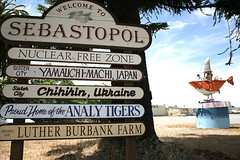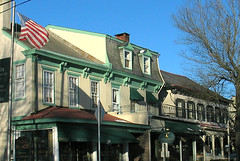Good conversation about small towns/cities and smart development

Posted July 7, 2008 at 1:56PM
I’ve written before about how smart growth principles can help smaller cities and towns (for example, here, here, and here). Heck, in many ways the traditional American town, with its main streets, court house and churches in the center of a very walkable downtown, is the very model of smart growth.
 Matthew Yglesias of theatlantic.com recently put up a post about how one such town, Sebastopol in the California wine country, is considering adding denser development to its downtown (up to 4-story buildings, so it would retain its small-town character) to re-establish a walkable core and reduce automobile dependence. A majority of the city council seems for it.
Matthew Yglesias of theatlantic.com recently put up a post about how one such town, Sebastopol in the California wine country, is considering adding denser development to its downtown (up to 4-story buildings, so it would retain its small-town character) to re-establish a walkable core and reduce automobile dependence. A majority of the city council seems for it.
As Yglesias says:
“One thing we don't necessarily give enough thought to is the extent to which increased density and small town living may be compatible. After all, it's not as if classic small town America was built during the era of the automobile. A small town can be small without being super-sprawly or organized in such a way that the only way to buy anything is to drive 30 miles to a mall.”
 Many of the comments on Yglesias’s post cite some great examples, such as Lambertville, New Jersey (George Washington has slept there, and so have I), Lexington, Virginia, Woodstock, Georgia, and various college towns. As one commenter put it:
Many of the comments on Yglesias’s post cite some great examples, such as Lambertville, New Jersey (George Washington has slept there, and so have I), Lexington, Virginia, Woodstock, Georgia, and various college towns. As one commenter put it:
“There's nothing more delightful than a smallish (but not tiny), highly walkable college town: plenty of shops, eateries, taverns, cultural amenities, businesses of every sort -- all tighly mixed in with eclectic residential buildings and all dispersed over a relatively small area -- and all of it conducive to lower stress, car-free living.”
Another commenter discusses the utility of one or two significant employers to enabling a small-town comeback:
“The thing about small towns - my model is the county seat - is that they're very flexible, because 19th century American town planning was simple and adaptable - the scale makes autos feasible, but in no way dictates driving for daily living . . .
“Probably the simplest solution for non-college towns is recruitment of the kinds of businesses that ‘til now have located in suburban office parks - drop a couple of 500 employee offices in the mid-height tower across from the courthouse, and you've got a daytime population to foster retail vitality, plus a group of people who have a huge incentive to live in town, or at the near margins. The business benefits from offering such a lifestyle to their employees, and, thanks to the courthouse, the necessary amenities for business are existing.”
There are some predictable naysayers, but on the whole the conversation is interesting and enlightening.
Many thanks to my colleague Andrew Wetzler for pointing me (again!) to Yglesias’s writing.